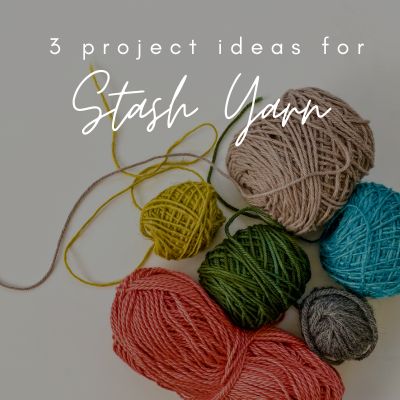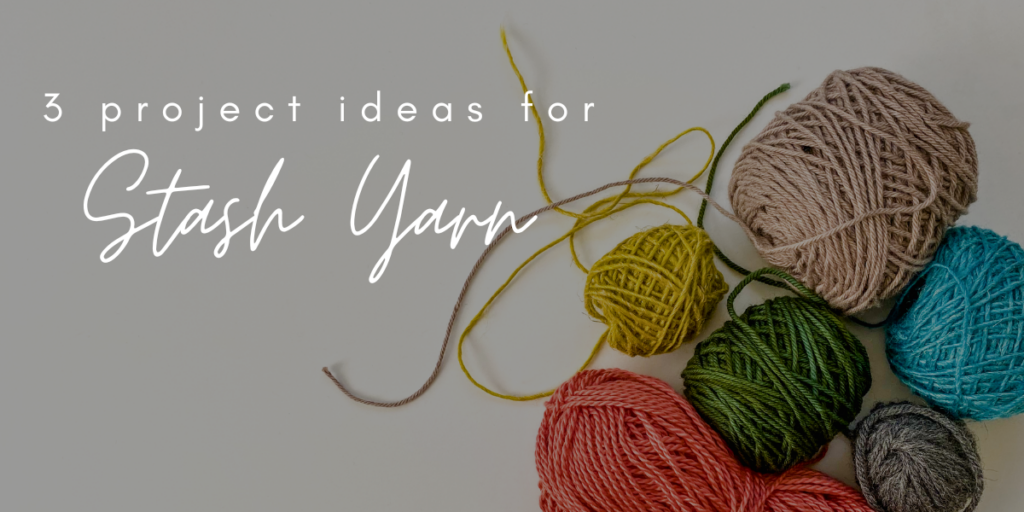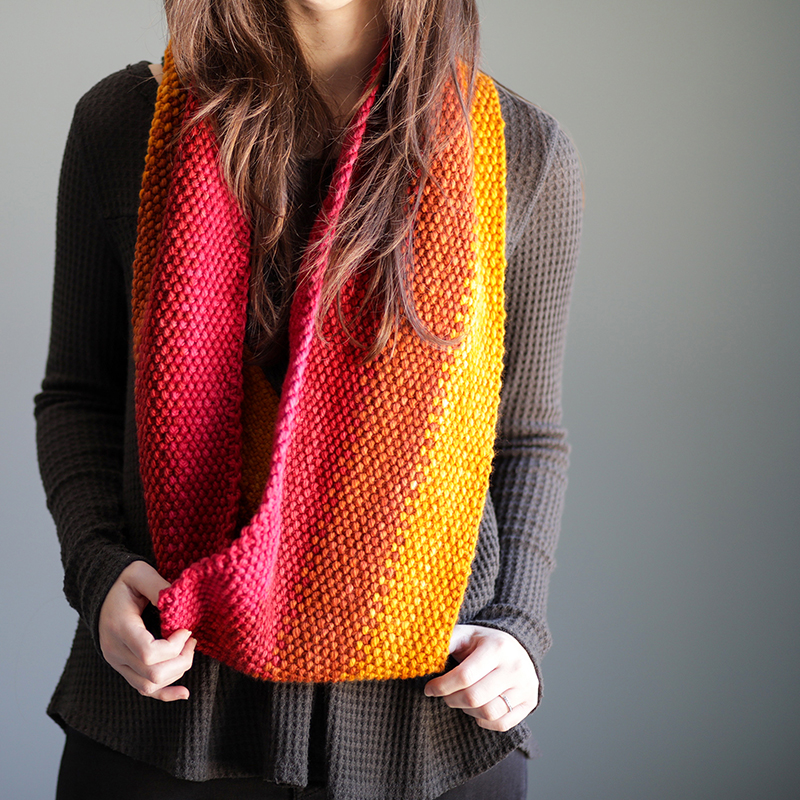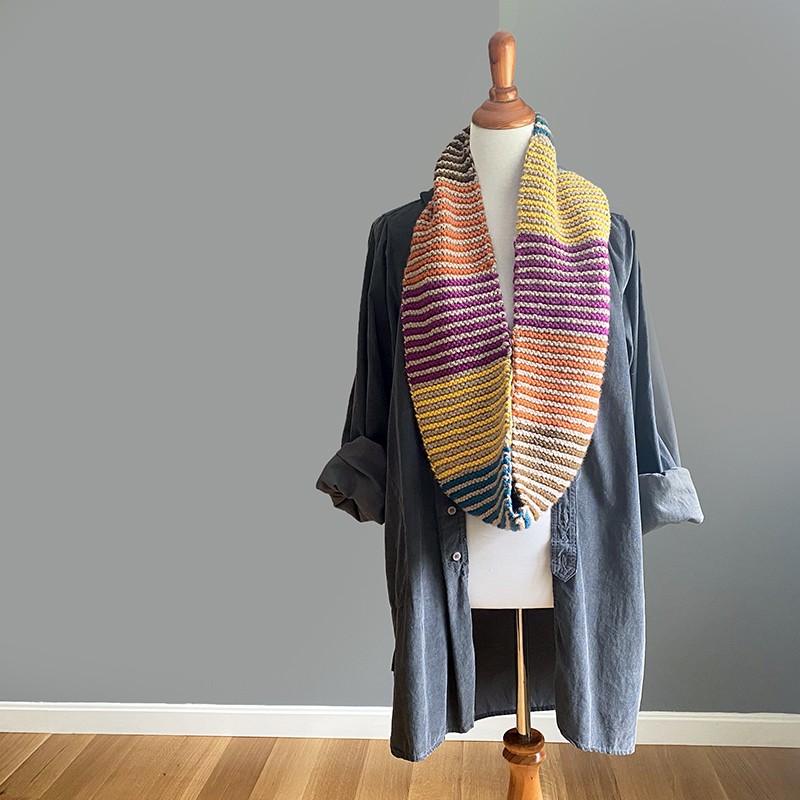It’s inevitable that the longer you are a knitter the more ‘stash yarn’ you’ll accumulate! Stash yarn consists of leftovers from previous projects, new yarns you couldn’t resist when you were visiting a local yarn shop or fiber fair, or yarns you had intended for a particular project but then changed your mind for one reason or another. Whatever it may consist of, almost all of us have stash yarn that we would like to use but often it’s hard to do so because we can’t find a project that’s a right match for it (whether because of gauge, fiber content or not having the right yardage amounts). So I thought I would share some project ideas that are ideal for stash yarn because a) gauge isn’t as critical with these and b) yardage amounts are flexible. So let’s dive in!
1. The Top-Down Shawl/Shawlette
The top-down shawl (or oftentimes called a shawlette or, simply, a triangle scarf) is ideal for stash yarn because gauge isn’t critical, any type of yarn will work for it, and you can adjust the size to work for the yardage amount you have (since you start with a small amount of stitches and then grow it out). If you would like a pattern to use as a template/recipe, my Airplane Mode (pictured above) is ideal for this. It’s a very simple top-down style – you would simply work sections 1 and 2 of the pattern (but disregarding colors/needle size/etc).
Here are things to keep in mind if you want to create a top-down shawl/scarf using stash yarn:
Choose a needle size based on the type of drape you want to have
Shawls and shawlettes are very flexible in terms of what type of needle size you use. It all depends on what type of drape you prefer and the yarn you are using. But there aren’t any “wrong” choices per say – you’ll just end up with looser or tighter fabric. It can be a fun way to experiment and learn about drape!
You can easily mix and match different colors
I’d suggest using like-yarns together (i.e, fingering-weight, worsted-weight, etc), but if you have a bunch of partial skeins of a particular weight, you can work stripes or color-blocking in order to use them all together.
Just end the shawl when you’re running low on yarn
One of the great things about this type of project is that it’s very flexible in terms of size. You can make a small top-down shawl that is worn more like a kerchief, or where you sew the ends together and it’s a little neckwarmer/cowl. Or if you have lots of stash yarn, you can make it nice and big and wear it like a wrap. You’re in control of when you decide to end it. Just make sure to leave enough yarn to work your bottom trim.
2. The Linen Stitch Cowl
Linen stitch, especially when worked in the round, is a simple stitch pattern and ideal for stash yarn because it combines different yarn colors together SO well. So this is a great project to consider when you have a bunch of different colors of a particular yarn weight (but perhaps not enough of 1 to do anything with). If you are looking for a template for this, check out my Flicker and Fade pattern (pictured above). And I wrote this blog post that provides tips on how many stitches to cast-on (and what needle size I suggest) for yarns that aren’t bulky-weight (since Flicker and Fade uses bulky).
Here are some other things to keep in mind if you knit a linen stitch cowl with stash yarn:
You will be on a needle size larger than you think
As I mention in the above linked blog post, linen stitch is very dense, so you typically want to use a needle size that is 2-3 sizes larger than what you typically would use with your chosen yarn. For example, DK-weight yarn is usually knit on a US 5 or 6, but in linen stitch I would suggest a US 8 or 9. For worsted-weight, you typically knit on a US 7 or 8 but in linen stitch I would suggest a US 10 or 10.5.
Cast-on an odd number of stitches
When worked in the round, linen stitch needs to be worked over an odd number of stitches. In the blog post I mentioned above I also provide suggested cast-on amounts for different yarn-weights and for both a short or long cowl. But you can feel free to adjust these as needed, just making sure it’s an odd number.
Have fun mixing colors!
Linen stitch is where you can really go nuts with color-play. Even colors you don’t think may go together somehow always look neat in linen stitch. And you can work them like I do in Flicker and Fade and work in color blocks, or you can work 2 colors throughout (like in striping), or a mix of both. Either way, you’ll be pleasantly surprised at how versatile linen stitch is and how much fun it can be to mix colors.
If you’re new to linen stitch, I have a video demo that walks you through it!
3. The Striped Scarf (that can be turned into a cowl!)
Stripes are a great way to use up stash yarn and working them in a scarf in garter stitch is super simple. But if scarves aren’t your thing, you can always turn the scarf into a cowl by sewing the ends together, or picking-up your cast-on edge and working the Three Needle Bind-Off. My Brightside Cowl is a great template for this – in it, I used leftover yarn from my Simply Stripes Baby Blanket (worked in Berroco Vintage Chunky). But in this blog post I talk about how to adjust the cast-on amount to work for other weight yarns too!
Here are some things to keep in mind if you knit a striped scarf (turned cowl) with stash yarn:
Garter stitch makes it easy-peasy
In my Brightside Cowl I use garter stitch because then you don’t have to worry about working an edge treatment (since stockinette stitch will just roll at the edges). Plus knitting every row is just so nice and easy, so it makes for great TV-watching knitting or when you bring a project to knit group.
Use 2 colors, or as many as you like!
What makes this great for stash yarn is that it can work for 2 colors, or 3, or more! In my Brightside cowl, I used 1 full skein of a main color but then 5 different contrasting colors (little bits of leftovers I had). This way I created 5 different striping sections where I always striped one of the contrasting colors with the main color. But depending on what you have available in your stash, you can play around with this and adapt it.
Not enough for a scarf? Make it a cowl!
Although in my Brightside Cowl pattern I knit it like a scarf until it measures approx. 48″ from the cast-on (and then I attached the ends together to make it a cowl), you can make yours shorter. So long as you attach your ends together like I did, you can make yours half as long and you’ll just have a shorter cowl. The minimum length would be around 22-24″ (for a neckwarmer-type piece). And if you’re striping different colors, that means you really don’t need a lot of yardage of each color to make it work.
If you’ve never worked 2 row stripes before, I made the below video demo that walks you through it!
I hope these 3 stash-yarn project ideas inspires you to dig into your stash yarn and give it new life!





